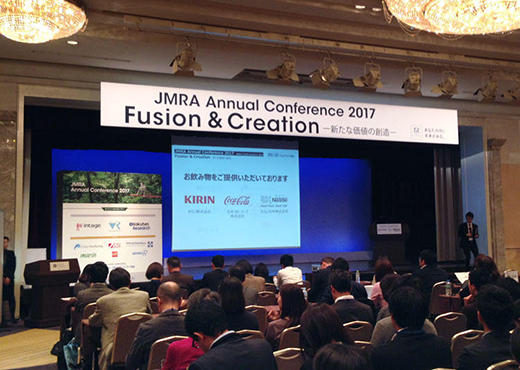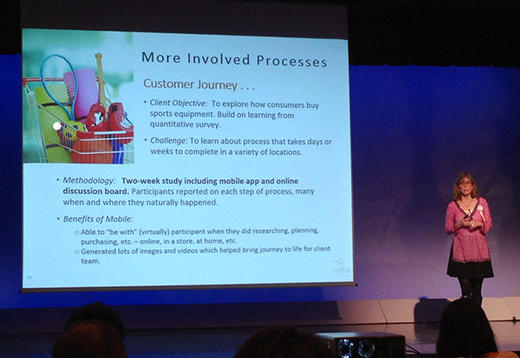Mobile Qualitative Research Takeaways from the JMRA Annual Conference 2017
UX Researcher - Serena LaiOn November 28, I attended the JMRA (Japan Marketing Research Association) Annual Conference hosted at the Hyatt Regency Tokyo. The event, held since 2005, provides participants the opportunity to learn about the latest global trends and developments in the marketing research industry. This year's talks were based on the theme "Fusion & Creation - Creating New Value", and looked at how marketing research today is not only about data analysis but about using advanced technologies and new research methods to bring more valuable customer insights to clients.
As a UX Researcher, I was interested in learning about popular global research methods since the toolbox that market and UX researchers draw from often overlap. For example, both use interviews, surveys, focus groups and other methods to collect information and learn about target audiences. Below are some of the takeaways from Dorrie Paynter's talk on "Qualitative Research in the US".

Digital Ethnography as a Solution to the Limitations of Face-to-face Research
With clients wanting in-depth and actionable insights into their customers faster than ever, the use of digital ethnography in qualitative research is steadily rising. In this method, participants use their own smartphones to record in-the-moment snapshots of their own customer journeys (or other experiences pertaining to a study goal). Collecting data with this approach is a powerful way to overcome limitations associated with face-to-face data collection. For example, digital ethnography helps overcome the following limitations associated with in-person interviews:
- Time constraints: the time needed to procure and setup a facility and to schedule in-person interviews is eliminated. Using their own smartphone devices, participants are free to record and share their experiences at their own convenience.
- Reliance on memory: for face-to-face interviews, researchers often need to rely on written notes to recall and report findings. With digital ethnography, researchers can directly share participant-recorded experiences.
- Participant responses being affected by a location or the presence of others: Peoples' demonstrated behaviour in a lab facility can vary from what they usually do. Their responses to questions can also be affected by how comfortable they are in the presence of researchers and observers. Digital ethnography enables participants to more freely express their thoughts and opinions while being in their natural surroundings and in the absence of strangers.
- Location constraints: when conducting face-to-face interviews, recruitment of participants often needs to be narrowed down to a certain city for logistical reasons. With mobile research, participants can be recruited from anywhere and cover a much larger geographic area.
Scenarios for Using Mobile Research
Apart from overcoming limitations associated with face-to-face interviews, digital ethnography is useful for hybrid studies. It enables clients to see real examples from participants about the what, where, when, how and why questions that pertain to a study. Below are some scenarios where mobile research can be useful for gathering quick, initial findings before the start of the main study.
- Completing pre-study homework in challenging environments - for example, asking participants to do a 1 week journal to capture issues they face when driving in different situations or places
- Taking researchers on a video tour of places where bringing a researchers or observers along is not feasible - for example, asking participants to show us their office work space
- Showing researchers how they do certain tasks - for example, asking participants to make a video to show us their in-store shopping experience while selecting and buying a certain product at their supermarket
- Doing a diary-type study to explore reactions to a product - for example, asking participants to record the ways they and their family use paper towels
Summary of the Benefits of Digital Ethnography
As seen above, there are many use cases where mobile research can be beneficial, especially when capturing findings from a challenging environment is necessary or desired. Below is wrap-up of the main advantages associated with conducting digital ethnography:
- Moderators, observers and participants can engage in research from anywhere, anytime
- Rich data can be easily collected in the form of mixed media (text, photos, videos and audio)
- It allows researchers and participants to capture experiences in the moment
- Researchers can learn from a single person (or many participants) multiple times at different stages of a process or experience
- Mobile research removes the need to rely on memory. Participants can use their devices to record, show and tell us what they do instead of just recounting their experiences
- Video recordings from mobile research allow us to see context and motion
- Participants have fewer inhibitions when voicing and sharing their experiences using their smartphone devices versus when they are in a lab environment
- Mobile research is often more cost-friendly and time-efficient than other qualitative research methods. Researchers can watch and learn from participants remotely, which saves travel time and money

Challenges of Conducting Mobile Research in Japan
During the talk, it was interesting to learn that Dorrie had conducted smartphone-based research not only in the US but also in Japan. So at the end of the session, I took the opportunity to ask if there were any cultural challenges she and her team faced. Apart from language-related issues and finding a mobile app that was suitable for conducting a study with Japanese users, it seemed that one of the unique aspects of mobile research in Japan is needing to consider how to put participants at ease.
While people in the US are quite open to accepting unexpected requests to video record and self-narrate an experience as it occurs in the moment, Japanese people need a bit of warning. This is because they tend to be more conscious of their appearance and surroundings, and would not want to look untidy nor want to inconvenience others while they video record something. For example, taking a video on your mobile phone while talking and simultaneously walking down a busy public street can be seen as rude in Japan. This is due to the potential nuisance you could cause others; with your attention divided, you might accidentally run into other people or others might need to go out of their way to avoid bumping into you. So to avoid causing any discomfort and awkwardness for Japanese participants, and to make local research go more smoothly, it is always best to inform Japanese people of any required tasks before a study begins so they can properly prepare themselves or share their potential concerns in advance.
